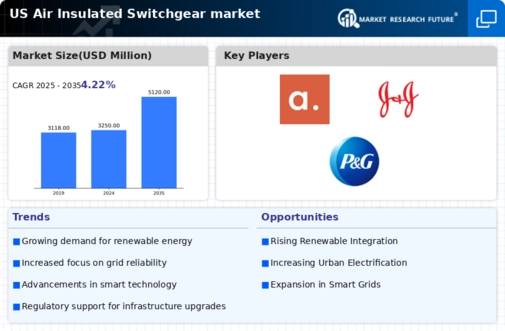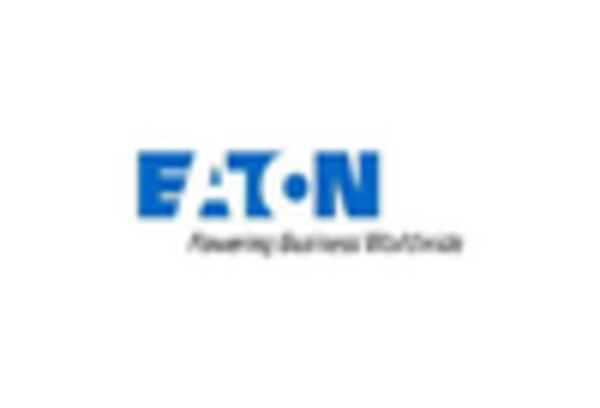Growth in Industrial Automation
The rise of industrial automation in the US is significantly impacting the switchgear market. As industries increasingly adopt automated processes, the demand for reliable and efficient electrical distribution systems grows. Switchgear is essential for controlling and protecting electrical equipment in automated environments, ensuring operational efficiency and safety. The manufacturing sector, in particular, is experiencing a surge in automation, with projections indicating a growth rate of 10% annually. This trend suggests that the switchgear market will benefit from increased orders for advanced switchgear solutions that can support automated systems, thereby enhancing productivity and reducing downtime.
Rising Demand for Renewable Energy
The increasing focus on renewable energy sources in the US is driving the switchgear market. As more solar and wind energy projects are developed, the need for reliable switchgear solutions becomes paramount. In 2025, renewable energy accounted for approximately 20% of the total energy generation in the US, and this figure is expected to rise. Switchgear plays a critical role in managing the distribution and integration of these energy sources into the grid. The transition to cleaner energy not only enhances energy security but also necessitates advanced switchgear technologies to handle variable power inputs. This trend indicates a robust growth trajectory for the switchgear market, as utilities and energy providers invest in modern infrastructure to support renewable energy integration.
Increased Focus on Safety Standards
Safety regulations and standards in the electrical industry are becoming increasingly stringent, which is influencing the switchgear market. The National Electrical Manufacturers Association (NEMA) and other regulatory bodies are continuously updating safety guidelines to ensure the reliability and safety of electrical equipment. As a result, manufacturers are compelled to innovate and enhance their switchgear products to comply with these evolving standards. This trend is likely to drive investments in research and development, leading to the introduction of safer and more efficient switchgear solutions. The emphasis on safety not only protects consumers but also enhances the overall reputation of the switchgear market, fostering trust among stakeholders.
Infrastructure Modernization Initiatives
The US government has initiated various infrastructure modernization programs aimed at upgrading aging electrical grids. These initiatives are likely to bolster the switchgear market as utilities seek to replace outdated equipment with more efficient and reliable switchgear solutions. The Biden administration's infrastructure plan allocates substantial funding for energy infrastructure improvements, which includes enhancing grid resilience and reliability. As a result, the switchgear market is poised for growth, with an expected increase in demand for advanced switchgear systems that can support smart grid technologies. This modernization effort not only addresses current challenges but also prepares the grid for future energy demands, thereby creating a favorable environment for switchgear manufacturers.
Expansion of Electric Vehicle Infrastructure
The rapid expansion of electric vehicle (EV) infrastructure in the US is creating new opportunities for the switchgear market. As the number of EV charging stations increases, the demand for robust electrical distribution systems becomes critical. Switchgear is vital for managing the electrical loads associated with EV charging, ensuring safe and efficient operation. The US government has set ambitious targets for EV adoption, aiming for 50% of new vehicle sales to be electric by 2030. This shift is likely to drive significant investments in charging infrastructure, thereby boosting the switchgear market as utilities and private companies seek to enhance their electrical systems to accommodate the growing demand for EV charging.

















Leave a Comment